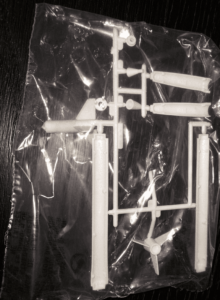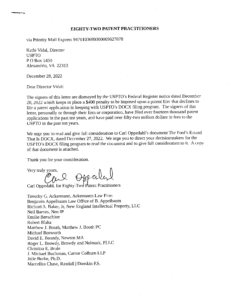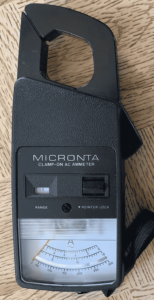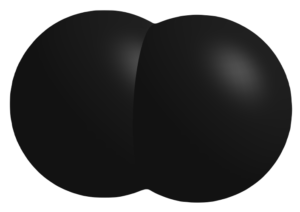 It turns out that anybody who wants to, can publish things on SSRN (Wikipedia article). SSRN, it will be recalled, is an initialism for Social Science Research Network (web site). To test this out, I created an account at SSRN and uploaded The Fool’s Errand that is DOCX. You can see it here: https://ssrn.com/abstract=4346907. This blog article describes the process and the results. Continue reading “Publishing things on SSRN!”
It turns out that anybody who wants to, can publish things on SSRN (Wikipedia article). SSRN, it will be recalled, is an initialism for Social Science Research Network (web site). To test this out, I created an account at SSRN and uploaded The Fool’s Errand that is DOCX. You can see it here: https://ssrn.com/abstract=4346907. This blog article describes the process and the results. Continue reading “Publishing things on SSRN!”
Maybe some USPTO progress away from bad parts of its DOCX initiative
(An important followup letter got sent on February 14, 2023 to the USPTO — see blog article.)
Readers, I am delighted to be able to report what looks like a bit of progress by the USPTO, away from some of the bad parts of its DOCX initiative. A meeting took place on February 1, 2023 with some representatives of the patent practitioner listserv committee. You can read about the meeting below. Continue reading “Maybe some USPTO progress away from bad parts of its DOCX initiative”
Paint first or glue first?

Folks, the subject line says it all. When I am assembling a plastic model kit, should I glue the parts together, and then paint the parts? Or (as the instructions seem to suggest) should I paint the parts first, and then glue them together? Continue reading “Paint first or glue first?”
Eighty-two patent practitioners write to Director Vidal about the DOCX initiative

Hello readers. You will recall (blog article of December 27, 2022) that the practitioner community was invited to sign a letter to USPTO Director Vidal. The letter urged her to read the document entitled The Fool’s Errand That Is DOCX, dated December 27, 2022, and the letter urged her to direct her underlings to read that document.
I am honored to be part of a community of eighty-two patent practitioners who signed that letter to Director Vidal.
This blog article reports that the letter did get sent to the USPTO. You can see the letter, which is dated December 28, 2022, here. The USPTO did receive the letter.
The next day, the USPTO blinked and postponed for another three months one of the really bad parts of its DOCX initiative. See Setting and Adjusting Patent Fees During Fiscal Year 2020, 87 Federal Register 80073, published December 29, 2022.
There is reason to think that the USPTO is moving, albeit slowly, toward yet another bit of progress away from really bad parts of its DOCX initiative, in addition to that blink on December 29, 2022. I hope to write another blog article soon about what might be another bit of progress.
Please take a look at the names of the eighty-two signers. Maybe you know some of them. If so, this might be a good time to say “thank you” to them.
USPTO doubles down on demanding to know where you sleep at night
(Update: the appellant’s reply brief has now been filed – blog article.)
Hello folks. It will be recalled that the Commissioner for Trademarks has shown an extremely strong interest in knowing where you sleep at night, if you happen to be an applicant in a trademark application. And in a brief filed yesterday at the Court of Appeals for the Federal Circuit, the Commissioner has now doubled down on demanding to know where you sleep at night. Continue reading “USPTO doubles down on demanding to know where you sleep at night”
Monaco Industrial Property Office is trendy, modern and up-to-date

The Monaco Industrial Property Office of the Business Development Agency, having joined the DAS system, is now trendy, modern, and up-to-date. (I first reported this to you on December 5, 2022.) Continue reading “Monaco Industrial Property Office is trendy, modern and up-to-date”
How clamp-on DC ammeters work

I imagine many readers of this blog have some idea how a clamp-on AC ammeter works. You have some wire with AC current in it, and you open the jaws of a clamp-on meter and you close them around the wire. The alternating current makes a constantly changing magnetic field around the wire. It is a fairly realistic goal for the jaws to capture basically all of the lines of (constantly changing) magnetic flux surrounding the wire. If you have the luxury of being able to assume that the frequency is known (and depending on the continent where you are located, this may well be a safe assumption), you can proceed in a very straightforward way to design a simple and inexpensive and quite accurate AC ammeter. I have had this Micronta (Radio Shack) meter (seen at right) in my tool kit for some fifty years now, and it has served me very well.
But nowadays there are clamp-on DC ammeters. A wire carrying a DC current does not (by definition it does not!) generate any changing magnetic field! A traditional meter like the one described above has nothing to measure if it is clamped onto a wire containing a DC current. How can a clamp-on DC ammeter possibly measure a (perhaps constant) DC current? Continue reading “How clamp-on DC ammeters work”
The 2022 Toteboards are now published
The 2022 US utility patent, US design patent, US plant patent, and US trademark registration toteboards are now published. You can see them here:
I am grateful as always to the hundreds of firms that contributed their numbers to these toteboards.
Last day to get in your numbers for the 2022 toteboards!
Today is the last day to get in your numbers for the 2022 toteboards. Click here to get in your numbers.
Here is what we have so far:
-
- For the US utility patent toteboard — over fifty firms responding, representing over thirty thousand issued US utility patents.
- For the US trademark registration toteboard — over fifty firms responding, representing over ten thousand granted US trademark registrations.
- For the US design patent toteboard — over forty firms responding, representing over four thousand issued US design patents.
- For the US plant patent toteboard — over three firms responding, representing over twenty-five US plant patents.
Get your numbers in. The response forms will stop taking responses at the close of business today, Tuesday, January 24, 2023.
Diatomic carbon

One of my pastimes is trying to guess which sound bites, if uttered at a cocktail party, might lead to the turning of heads and might lead to other party guests clustering around with great interest. (See past blog articles.) Here is another: diatomic carbon. Continue reading “Diatomic carbon”
